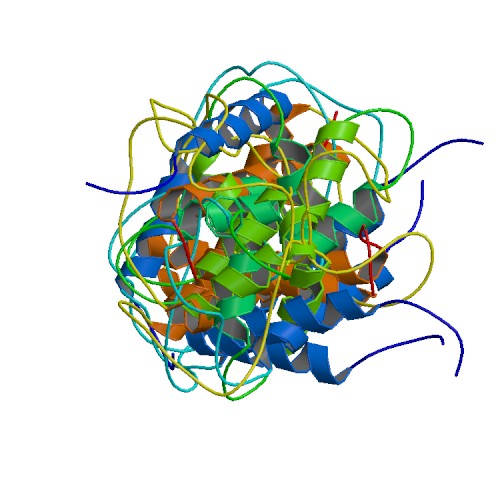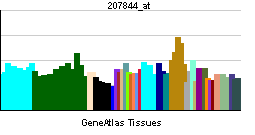Interleukin 13
| Interleukin 13 | |||||||||||
|---|---|---|---|---|---|---|---|---|---|---|---|
 PDB rendering based on 1ga3. | |||||||||||
| Identifiers | |||||||||||
| Symbols | IL13 ; ALRH; BHR1; IL-13; MGC116786; MGC116788; MGC116789; P600 | ||||||||||
| External IDs | Template:OMIM5 Template:MGI HomoloGene: 1649 | ||||||||||
| |||||||||||
| RNA expression pattern | |||||||||||
 | |||||||||||
| More reference expression data | |||||||||||
| Orthologs | |||||||||||
| Template:GNF Ortholog box | |||||||||||
| Species | Human | Mouse | |||||||||
| Entrez | n/a | n/a | |||||||||
| Ensembl | n/a | n/a | |||||||||
| UniProt | n/a | n/a | |||||||||
| RefSeq (mRNA) | n/a | n/a | |||||||||
| RefSeq (protein) | n/a | n/a | |||||||||
| Location (UCSC) | n/a | n/a | |||||||||
| PubMed search | n/a | n/a | |||||||||
Overview
Interleukin 13 (IL-13) is a cytokine secreted by many cell types, but especially T helper type 2 (Th2) cells[1], that is an important mediator of allergic inflammation and disease.
Functions
In addition to effects on immune cells that are similar to those of the closely related cytokine IL-4, IL-13 is more importantly implicated as a central mediator of the physiologic changes induced by allergic inflammation in many tissues. IL-13 induces its effects through a multi-subunit receptor that includes the alpha chain of the IL-4 receptor (IL-4Rα), which is also a component of the IL-4 receptor, and at least one of two known IL-13-specific binding chains[1]. Most of the biological effects of IL-13, like those of IL-4, are linked to a single transcription factor, signal transducer and activator of transcription 6 (STAT6).
The functions of IL-13 overlap considerably with those of IL-4, especially with regard to changes induced on hematopoietic cells, but these effects are probably less important given the more potent role of IL-4. Thus, although IL-13 can induce immunoglobulin E (IgE) secretion from activated human B cells, deletion of IL-13 from mice does not markedly affect either Th2 cell development or antigen-specific IgE responses induced by potent allergens. In comparison, deletion of IL-4 abrogates these responses. Thus, rather than a lymphoid cytokine, IL-13 acts more prominently as a molecular bridge linking allergic inflammatory cells to the non-immune cells in contact with them, thereby altering physiological function.
Although IL-13 is associated primarily with the induction of airway disease, it also has anti-inflammatory properties. Airway matrix metalloproteinases (MMPs), which are protein-degrading enzymes, are required to induce egression of effete parenchymal inflammatory cells into the airway lumen where they are then cleared. Among other factors, IL-13 induces these MMPs as part of a mechanism that protects against excessive allergic inflammation that predisposes to asphyxiation.
Clinical significance
IL-13 specifically induces physiological changes in parasitized organs that are required to expel the offending organisms or their products. For example, expulsion from the gut of a variety of mouse helminths requires IL-13 secreted by Th2 cells. IL-13 induces several changes in the gut that create an environment hostile to the parasite, including enhanced contractions and glycoprotein hyper-secretion from gut epithelial cells, that ultimately lead to detachment of the organism from the gut wall and their removal.
The eggs of the parasite Schistosoma mansoni may lodge in a variety of organs including the gut wall, liver, lung and even central nervous system, inducing the formation of granulomas under the control of IL-13. Here, however, the eventual result is organ damage and often profound or even fatal disease, not resolution of the infection. An emerging concept is that IL-13 may antagonize Th1 responses that are required to resolve intracellular infections. In this immune dysregulated context, marked by the recruitment of aberrantly large numbers of Th2 cells, IL-13 inhibits the ability of host immune cells to destroy intracellular pathogens.
IL-13 induces many features of allergic lung disease, including airway hyperresponsiveness, goblet cell metaplasia and mucus hypersecretion, which all contribute to airway obstruction [2]. IL-4 contributes to these physiologic changes, but is less important than IL-13. IL-13 also induces secretion of chemokines that are required for recruitment of allergic effector cells to the lung. Studies of STAT6 transgenic mice suggest the interesting possibility that IL-13 signaling occurring only through the airway epithelium is required for most of these effects. While no studies have yet directly implicated IL-13 in the control of human diseases, many polymorphisms in the IL-13 gene have been shown to confer an enhanced risk of atopic respiratory diseases such as asthma.
See also
IL-13R, the IL-13 receptor
References
Further reading
- Marone G, Florio G, Petraroli A, de Paulis A (2001). "Dysregulation of the IgE/Fc epsilon RI network in HIV-1 infection". J. Allergy Clin. Immunol. 107 (1): 22–30. PMID 11149986.
- Marone G, Florio G, Triggiani M; et al. (2001). "Mechanisms of IgE elevation in HIV-1 infection". Crit. Rev. Immunol. 20 (6): 477–96. PMID 11396683.
- Skinnider BF, Kapp U, Mak TW (2003). "The role of interleukin 13 in classical Hodgkin lymphoma". Leuk. Lymphoma. 43 (6): 1203–10. PMID 12152987.
- Izuhara K, Arima K, Yasunaga S (2003). "IL-4 and IL-13: their pathological roles in allergic diseases and their potential in developing new therapies". Current drug targets. Inflammation and allergy. 1 (3): 263–9. PMID 14561191.
- Dessein A, Kouriba B, Eboumbou C; et al. (2005). "Interleukin-13 in the skin and interferon-gamma in the liver are key players in immune protection in human schistosomiasis". Immunol. Rev. 201: 180–90. doi:10.1111/j.0105-2896.2004.00195.x. PMID 15361241.
- Copeland KF (2006). "Modulation of HIV-1 transcription by cytokines and chemokines". Mini reviews in medicinal chemistry. 5 (12): 1093–101. PMID 16375755.